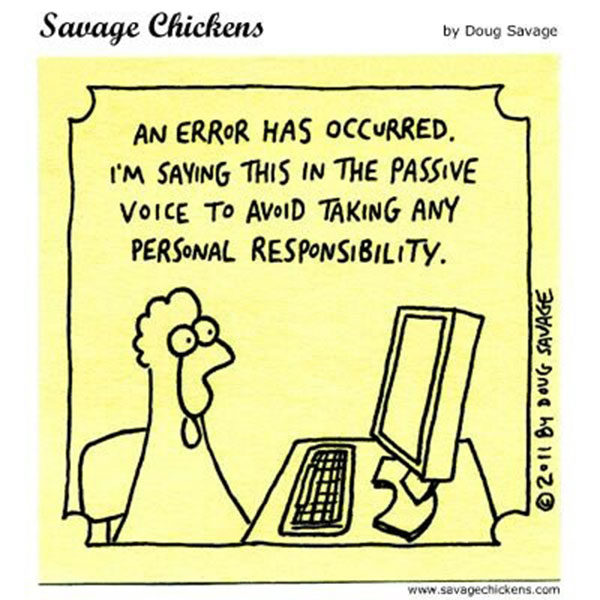
Which of these sentences makes you more likely to sit up and take notice?
- 'The content designer pulled out her red pen and started editing like crazy.’
- 'Her red pen was pulled out by the content designer and was put to work like crazy.’
The first sentence is written in the ‘active’ voice. The second sentence, which is longer and harder to read, is written in the ‘passive’ voice.
It’s part of a content designer’s job to make content as easy as possible to understand online. That’s why we prefer the active voice in almost all cases.
So what are the active and passive voices, exactly? They’re not ways of describing how ‘pacy’ – or not – a sentence is. Instead, they’re grammatical terms for the way a sentence is put together.
The difference between the two ways of writing a sentence is easy to understand. An active sentence makes clear who is doing what by putting the subject of the sentence – the person or thing doing something – up front. A passive sentence sometimes gets rid of the subject altogether.
Here’s an example. Think of buying something online. You need a receipt for the £50 you’ve just spent. An active voice response might be: 'We will email you a receipt.' A passive response, on the other hand, would be: 'Your receipt will be sent.'
In the passive version of the sentence, you don’t know who actually sent the receipt – which might be kind of inconvenient if your receipt doesn’t show up. Who was supposed to have sent it?
To take another, classic example: ‘The cat sat on the mat’ is an active sentence. But the passive version would be: ‘The mat was sat on.’ You don’t even have to add ‘by the cat’ for the sentence to make sense.
Passive sentences are great for avoiding responsibility. They don’t need to tell you who actually did something, so you don’t know who to blame. Be wary of prose that’s full of the passive voice.
The Grammar Girl blog gives another example. In the Marvin Gaye song 'I Heard It Through the Grapevine', "I" is the subject – the one doing the action. "I" is hearing "it", the object of the sentence.
If you wanted to make the title of the Marvin Gaye song passive, Grammar Girl explains, you would say: ‘It was heard by me through the grapevine’ – not such a catchy title.
Using the active voice is one of the principles of writing in plain English. The active voice helps to make GOV.UK guidance, for example, as clear as possible.
Here are some more examples of passive versus active that are the kind of thing content designers deal with on GOV.UK:
| Passive | Active |
| This document has also been produced in a PDF | You can download this guide as a PDF |
| Carrier bags must be sold to shoppers for at least 5p | You must charge at least 5p for a carrier bag |
| A decision was made by the Board of Directors to review the file. | The Board of Directors decided to review the file. |
| A replacement form will be sent to your contractor by the Environment Agency. | The Environment Agency will send a replacement form to your contractor. |
Active voice in titles
Using verbs rather than nouns in titles for example, ‘Submit Statutory Declarations’ not ‘Statutory declarations submissions ’ lets users understand what a guide will help them do.
Front-loading a title using the active voice – for example, ‘Export plants, seeds, bulbs and wood’ rather than ‘Special rules for exporting plants, seeds, bulbs and wood’ – helps users find content easily in search.
But it’s not always essential or beneficial to make titles active. Research by the Nielsen Norman Group explains the importance of front-loading:
Recent findings from our eyetracking research emphasised the importance of getting the first two words right, since that's often all users see when they scan web pages. Given this, we have to bend the writing guidelines a bit, especially for elements that users fixate on when they scan – that is, headlines, subheads, summaries, captions, hypertext links, and bulleted lists.
It’s the content designer’s job to use writing guidelines to create a title that explains the content’s function and that users can find online. Tools such as the Hemingway Editor app make it easier by highlighting uses of the passive voice in text.
If you want an easy tip for making your own writing more punchy and effective, you should develop a preference for the active voice, too.
